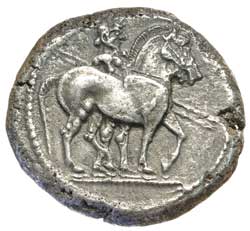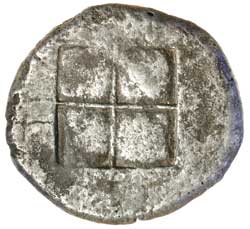Greek Silver & Bronze
Lot 3228 Session 11 (9.30am Friday) Greek Silver & Bronze
Estimate $12,000
Bid at live.noble.com.au
THRACO-MACEDONIAN, The Bisalti tribe, (c.479-465 B.C.), AR octodrachm, (26.98 grams), obv. bridled horse walking right; behind is a young man wearing a petasos holding two spears pointed forward, dotted border, rev. quadripartite incuse, square, (S.1318, cf. SNG Ashmolean 2242; cf.Svoronos 16, pl. XII, 4 = Jameson 938 [SOD]). Lightly toned, nearly extremely fine with some minor graininess.
This impressive coin of the Bisalti shows a young man leading a horse wearing a traditional northern hat which is like a petasus worn by the Macedonians and Thessalians.In addition he carries two spears. He has been identified as Rhesus or Ares, but it is uncertain if he actually represents a true mythical figure. Thrace was in the late sixth century part of the Persian Empire and the Bisalti were a strong and somewhat independent force, as they refused to assist the Great King of Persia when his army crossed Thrace to invade mainland Greece in 480 B.C. Later the Bisalti lost their power, probably to Alexander I of Macedon, the new power in the region after the Persian defeat (who also struck octodrams which are very similar to the issues of the Bisalti). These heavy coins of the Bisalti have been found in hoards from Egypt and other parts of the Persian Empire. They were not part of the famous Asyut hoard of Egypt which was buried about 475 B.C. and its absence does suggest a somewhat later date for this octodram of the Bisalti. It has been suggested that the Bisalti won control of the silver mines around Lake Prasias and that their coinage was terminated around the time of the foundation of the Athenian colony at Ennea Hodoi and the subsequent disaster at Drabescus in 465-4 B.C. This battle, in which the Athenian colonists were exterminated by the native Thracians, may have enabled Alexander I of Macedon to take possession of the mines for himself. Several examples in recent years have sold in the international auction market up to $25,000. This example compares favourably with these pieces and could bring a slightly lesser amount.
Estimate / sale price does not include buyer's premium (currently 22% including GST) which is added to hammer price. All bids are executed on the understanding that the Terms & Conditions of sale have been read and accepted. For information on grading and estimates please refer to the Buying at Auction advice.
Quick find
View a lot by number and sale.
Adjacent lots
Lot 3226
THRACE, Island off Thrace, Thasos, (c.510-490 B.C.), silver stater, (7.884 grams), obv. naked ithyphallic Satyr ...
Estimate $500
Lot 3227
THRACE, Kingdom of, Lysimachos, (323-281 B.C.), silver tetradrachm, (16.934 grams), Lampsacus mint, issued 297/6-282/1 B.C., ...
Estimate $700
Lot 3228 This lot
THRACO-MACEDONIAN, The Bisalti tribe, (c.479-465 B.C.), AR octodrachm, (26.98 grams), obv. bridled horse walking right; ...
Estimate $12,000
Lot 3229
MACEDON, Kingdom of, Alexander III, (336-323 B.C.), silver tetradrachm, (16.756 grams), Amphipolis mint, issued c.315-294 ...
Estimate $200
Lot 3230
MACEDON, Kingdom of, Alexander III, (336-323 B.C.), silver tetradrachm, (17.072 grams), Corinth mint, issued c.310 ...
Estimate $650

